
A key decision was made by the Supreme Court of India in the matter of Reliance General Insurance Co. Ltd. vs. Swati Sharma & Others. The court made its decision about the issue of contributory negligence in a case involving an automobile accident.
A sad road accident occurred in this instance, in which the victim, who was riding a motorcycle, was struck by a truck and suffered fatal injuries as a result of the collision. The highest court,
which was comprised of Justices K. Vinod Chandran and Sudhanshu Dhulia, came to the conclusion that the truck driver and his insurance are solely responsible for the tragedy. They rejected the insurer’s contention that the victim was responsible for the disaster.
For any queries or to publish an article or post or advertisement on our platform, do call at +91 6377460764 or email us at contact@legalmaestros.com.
A Concise Review of the Situation
The plaintiffs’ son, who was also their spouse, was killed in a deadly car accident when he was struck by a truck.
The action was brought about as a result of this vehicle accident. An application for compensation was submitted by the deceased person’s wife and mother in the form of a claim petition.
The Motor Accidents Claims Tribunal (MACT) determined that both parties were negligent and assigned fifty percent of the responsibility for the accident to the truck’s insurance company. Appealing this judgment was something that both the claimants and the insurance company did since they were unhappy with it.
For any queries or to publish an article or post or advertisement on our platform, do call at +91 6377460764 or email us at contact@legalmaestros.com.
In contrast, the High Court took a different stance. In light of the fact that the evidence was reexamined, it was determined that the truck driver was wholly responsible, and the amount of compensation was increased. In a case that was brought before the Supreme Court, the insurance company contested this verdict.
The Primary Concern Before the Court
The primary legal question that needed to be answered in this case was whether or not the deceased biker was partially liable for the accident. If this was the case, then the truck driver’s culpability would be reduced, and the insurer’s liability would also be reduced.
Contributory negligence is the term that this is known by in the legal system. The insurance company maintained that there was an overwhelming amount of evidence that pointed towards the occurrence of negligence on the part of the motorcyclist.
For any queries or to publish an article or post or advertisement on our platform, do call at +91 6377460764 or email us at contact@legalmaestros.com.
This evidence included statements from the truck driver and the police officer who was conducting the investigation.
On the other hand, the plaintiffs presented the argument that the entire collision was brought about by the hasty and careless driving of the truck driver who came from the wrong side of the road.
Evidence reviewed by the Supreme Court of the United States
The testimony of the truck driver, the officer who was conducting the investigation, and an eyewitness who was riding another bike behind the deceased person was all taken into consideration by the Supreme Court.
For any queries or to publish an article or post or advertisement on our platform, do call at +91 6377460764 or email us at contact@legalmaestros.com.
The driver of the truck said that there was no accident at all and that the only reason he was involved was because he was operating a larger vehicle to begin with.
Under cross-examination, the police officer admitted that he had submitted a charge sheet against the truck driver alone and that the position of the motorbike may have been adjusted before he arrived at the accident site. However, he did not deny that he had supported the claim of contributory fault.
In the statements that the driver and the officer made, the court discovered inconsistencies that contradicted each other. In his statement, the driver stated that he ran away from the scene, stating that he was afraid of being beaten by witnesses. He later reported the event to the authorities.
For any queries or to publish an article or post or advertisement on our platform, do call at +91 6377460764 or email us at contact@legalmaestros.com.
However, the eyewitness (PW3) was the one who filed the first information report, and not the truck driver.
It was made abundantly evident by PW3, the third independent eyewitness, that both bicycles were being driven at a regular pace when the vehicle, which was traveling from the opposite direction, collided with the bicycle of the dead.
Moreover, he stated that the truck driver had driven recklessly and irresponsibly, and that he had fled the site of the collision after it occurred.
For any queries or to publish an article or post or advertisement on our platform, do call at +91 6377460764 or email us at contact@legalmaestros.com.
Rejection of Negligence Contributing to the Accident
The court did not agree with the insurer’s allegation that they were responsible for the accident. It was determined that the testimony of the truck driver was not trustworthy and was motivated by self-interest.
There were inconsistencies and contradictions between the comments made by the officer who was conducting the investigation and the formal charge sheet that he had submitted. The court was not persuaded by his feeble reason for not filing charges against the biker who had passed away during the incident.
On the other hand, the evidence of the eyewitness was seen as being believable. A consistent description of the accident was provided by him, including the route, the way in which he drove, and the immediate aftermath of the incident. He did not appear to have any obvious reason to lie.
For any queries or to publish an article or post or advertisement on our platform, do call at +91 6377460764 or email us at contact@legalmaestros.com.
A Reiteration of The Legal Principles
A number of significant legal concepts were vindicated by the verdict made. In the first place, it brought attention to the idea of vicarious culpability in situations involving automobile accidents.
The person who owns a vehicle is held vicariously accountable for the activities of his employee, who is the person who drives the vehicle. In accordance with the provisions of the insurance contract, the truck’s insurer was obligated to compensate the owner of the truck because it was determined that the truck driver was fully responsible for the accident.
Second, the Court stressed how important it is to evaluate the reliability of witnesses when it comes to compensation claims for accidents. There is more weight placed on testimony that is independent and consistent as opposed to evidence that is biased or conflicting.
For any queries or to publish an article or post or advertisement on our platform, do call at +91 6377460764 or email us at contact@legalmaestros.com.
In conclusion, the Court reaffirmed that the allocation of responsibility in situations involving contributory negligence must be contingent upon the existence of substantial evidence. If the information that is available overwhelmingly supports the idea that one party is fully liable for the damages, then the courts are not allowed to water it down in the name of apportionment.
What the Court Decided
The verdict of the High Court was affirmed by the Supreme Court, and the Special Leave Petition that was submitted by Reliance General Insurance Co. Ltd. was rejected. It was determined that the truck driver was solely responsible for the accident, and as a result, the insurance company was as well.
In addition, the court gave its approval to the increased compensation that was given to the claimants and issued an order that the funds that were owed to them be paid to them as soon as possible by RTGS transfer.
For any queries or to publish an article or post or advertisement on our platform, do call at +91 6377460764 or email us at contact@legalmaestros.com.
Further-Reaching Consequences
When it comes to claims involving automobile accidents, this decision has far-reaching repercussions. It establishes a precedent for insurance companies that are seeking to decrease their culpability by claiming that the plaintiff was contributed to the accident without providing sufficient evidence.
In addition to this, it offers victims and their families solace and justice, while also reiterating that the law will not permit technical defenses to take precedence over legitimate claims.
The Court guaranteed that justice was accomplished in a delicate issue that included the loss of life by firmly relying on consistent witness evidence and rejecting erroneous reasoning by the authorities who were conducting the investigation. Additionally, the ruling affirms the concept that substantive justice and procedural fairness must go hand in hand within the same framework.
For any queries or to publish an article or post or advertisement on our platform, do call at +91 6377460764 or email us at contact@legalmaestros.com.
The verdict that the Supreme Court handed down in the matter of Reliance General Insurance Co. Ltd. vs. Swati Sharma sends a powerful message to legal practitioners and insurers who are involved in instances involving motor vehicle accidents.
Specifically, it highlights the duty of care that drivers of heavy vehicles are obligated to uphold, the obligation that insurers have, and the need of convincing evidence for assessing culpability. As a result, it places an emphasis on justice for the families who are suffering and protects the dignity of the legal system in terms of paying for unlawful losses.




![Research Assistantship @ Sahibnoor Singh Sindhu, [Remote; Stipend of Rs. 7.5k; Dec 2025 & Jan 2026]: Apply by Nov 14, 2025!](https://legalmaestros.com/wp-content/uploads/2025/11/Gemini_Generated_Image_s0k4u6s0k4u6s0k4-768x707.png)
![Karanjawala & Co Hiring Freshers for Legal Counsel [Immediate Joining; Full Time Position in Delhi]: Apply Now!](https://legalmaestros.com/wp-content/uploads/2025/11/Gemini_Generated_Image_52f8mg52f8mg52f8-768x711.png)
![Part-Time Legal Associate / Legal Intern @ Juris at Work [Remote]: Apply Now!](https://legalmaestros.com/wp-content/uploads/2025/11/ChatGPT-Image-Nov-12-2025-08_08_41-PM-768x768.png)
![JOB POST: Legal Content Manager at Lawctopus [3-7 Years PQE; Salary Upto Rs. 70k; Remote]: Rolling Applications!](https://legalmaestros.com/wp-content/uploads/2025/11/ChatGPT-Image-Nov-12-2025-08_01_56-PM-768x768.png)